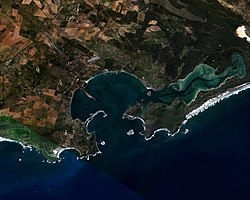Langebaan
As far back as 500 000 years ago, early Homo sapiens were probably present in the area, living in groups and hunting small game, displacing carnivores, such as lions, from their kills and gathering plant foods.
They used animal skins for warmth and clothing, and also made wooden and stone tools, as evidence of these found here proves.
The first European to set foot on land was Vasco da Gama at St Helena Bay on the West Coast Peninsula in 1497.
Many stirring events have occurred in the region over the centuries including two sea battles and a visit by the Confederate States of America’s, Alabama, in 1863, the most feared warship of its day.
Even the five islands in the area, which are administered by the West Coast National Park, have a history of their own, including battles for ownership, use as smallpox quarantine hospitals, exploits for guano, sealing centres and other activities.
The French used Schaapeneiland (close to Langebaan beach) as a storage place for whale oil and seal hides, calling it "Isle à la Biche".
[2] Bird-watchers visit the area to view the over 300 species of birds found in the lagoon waters of the West Coast National Park.
Community events includes the church bazaar and the annual Langebaan Mussel Festival, which takes place on the first weekend of October.

